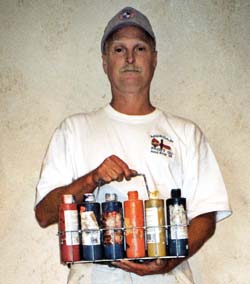
Tracy Wickwire,
Cloud Cap Painting, Inc.,
Mt. Hood, Oregon
by John Strieder
about 60 miles east of Portland, Ore., is a tourist's dream — woodland hikes, sweet-smelling orchards, and the snowy slopes of majestic Mt. Hood, which looms to the south.
But this picturesque region has its share of homeowners too. And given the scenery, it's only natural that some would want to pretty up their decks, porches and floors.
And that's where Tracy Wickwire comes in. A fourth-generation painter who learned his trade in the ritzy homes of Hollywood and Beverly Hills, Wickwire works from his home office near Mt. Hood, Ore.
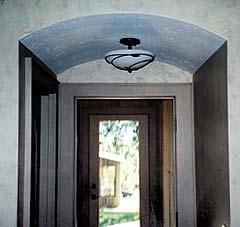 Doing business as Cloud Cap Painting Inc., he is introducing old-fashioned technique to an area rich with artistry and tradition. Doing business as Cloud Cap Painting Inc., he is introducing old-fashioned technique to an area rich with artistry and tradition.
His first job in the region was a house for an orchard. The owners had reclaimed wood from old picker shacks for walls, and wanted a similarly old-fashioned look from Wickwire's brush. He hand-mixed virtually every shade of paint he used. By the time he was finished, he says, the new house looked a century old.
He does mottling, marbleizing, European-style mixing and wood-graining. He's made sheetrock look like walnut, maple handrails look like hand-rubbed iron, and fiberglass doors look like old wood. “I go into a house and without tearing out a thing, completely change it,” he says.
Wickwire uses a family recipe to create four-color Venetian plaster. His dad burnished with pumice stone, while Tracy uses a trowel or 100-grip sandpaper, but the results are the same. “It's got a haze of lime coming through,” he says. “It looks very old. You can see the colors peek through when you look.”
The only thing he can't do, he says, is draw. “If I try to draw a horse it looks like a dog.”
And word of his skills has spread across the Columbia River into the state of Washington. An architect there hired him to paint a concrete floor as travertine tile to match the shower in an apartment. “He says you can't tell the difference,” Wickwire boasts. “It's quite the talk.”
Tracy Wickwire describes himself as a true third-generation painter, not counting his great-grandfather.
Wickwire's grandfather painted everything from houses to cars, and on top of that, had a contract with Coca-Cola to paint advertisements for the soft drink on billboards and barns. He kept busy at home too. He and his wife raised 11 children — eight boys, all painters.
In the 1940s, Tracy's father was hired by a Los Angeles company to match paint colors on cars. Eventually, he branched into painting homes in Hollywood and Beverly Hills.
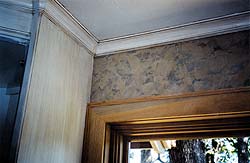
, and as he grew, he worked alongside his father, learning how to paint stucco, plaster and the rest. “My dad used to say, if you can't patch a hole in the middle of a wall and match the color so when you leave you can't tell, you're not doing your job.”
Their clients were mainly the likes of interior designers and doctors, Tracy Wickwire remembers. “We did work for a fellow who used to make Lorne Greene's hairpieces. We did a lot of fire jobs after Watts burned down.”
His father died while painting a house. “He was wrapping a hose up on the spray rig in front of the garage,” Tracy says. “He had just made the last wrap on the spray rig.”
After Wickwire moved to Oregon in 1979, he logged time in the maintenance departments of state colleges. His claim to fame at Portland State was constructing a 56-foot conference table to Secret Service specifications for a conference attended by President Clinton.
He founded Cloud Cap Painting in 1995, taking the name from the orchard that was his first client in that region. “There's a cloud cap right up Highway 35,” he notes. “I have one of the most beautiful views of Mount Hood right out my window.”
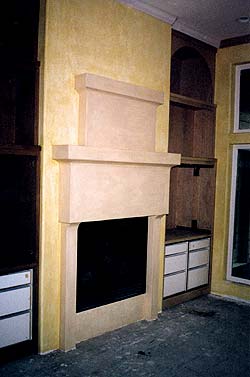 Wickwire claims he is the only painter in the area who carries a color rack. “When I grew up that was part of being a painter,” he says. “You were supposed to match any color on the job, not run down to the paint store. In a short period of time, I can come up with a sample that they like and I like.” Wickwire claims he is the only painter in the area who carries a color rack. “When I grew up that was part of being a painter,” he says. “You were supposed to match any color on the job, not run down to the paint store. In a short period of time, I can come up with a sample that they like and I like.”
While Wickwire specializes in faux painting, it's a term he despises. “I think it's a terrible name,” he declares. “It sounds to me to be phony.”
The practice has been around for a long time, he says, at least since Europe at the turn of the century, which is why he likes to call it “Tiffany painting.” Wallpaper supplanted it in the 20th century, he says, but it's coming back.
“In Portland 10 or 12 years ago I carried around all the sample boards I did,” he muses. “Nobody was really interested in it. They were all still into wallpaper. So I threw all the boards away.”
But paint can do things wallpaper can't. Different colors in the mix become dominant at certain points of the day, responding to the light. “Decorative painting changes dramatically with the time of day,” he says. “It gives the feeling that it's alive. Not just blah, not just there. It's alive.”
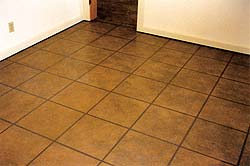
Wickwire's job often expands into the role of interior decorator, something he doesn't mind at all. “When I grew up, interior decorating wasn't a separate trade. That's what you were,” he says. “I think it's a real personal thing to go sit down and feel out what somebody wants, since often they are so confused.”
“My dad always taught me: When somebody asks you if you can do something, you just say yes, whether you can do it or not. Then I go home and perfect it. Be positive, be reassuring. Reassure them you can give them what they want.”
He's happy to pass on other bits of family wisdom too. For instance, never judge a job on the day you do it. Wait a day or two, then look at it again.
And commit a formula to paper every once in a while, he says, but don't be afraid to improvise. “Creating is what it's really all about. Every room, every painting you do is individual. None are ever going to be identical.”
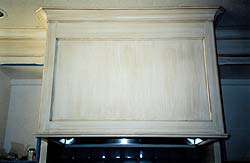 Demand for his skills is on the rise, he says. “The decorative trend right now is certainly alive, and I am seeing more of it,” he says. “A lot of painters here want to work with me. They want to learn what I know.” Demand for his skills is on the rise, he says. “The decorative trend right now is certainly alive, and I am seeing more of it,” he says. “A lot of painters here want to work with me. They want to learn what I know.”
People call his house all the time asking for advice, he says. “I had a lady hug me at the post office: ‘Remember me?’ ‘I don't think so.’ She had me tell her how to do a particular kind of decorative painting. She had done it, and she said it turned out gorgeous.”
Wickwire is writing scripts for training videos that would teach his tools, techniques and materials. “Some people make decorative painting sound like it's really hard to do,” he says, “but it's not.”
The tapes would help ensure that the Wickwire legacy endures. Tracy's son, 11, is carrying the torch in his own way. He won a national colored drawing contest sponsored by a phone company when he was in first grade. “He's quite artsy himself,” his father beams. “He actually inspired me.”

|

